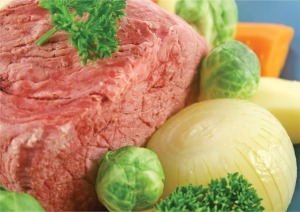
People, I will just warn you that I don't hold any recipe as sacred. So, if anyone is offended by the fact that I have both experimented upon and adapted Julia Child's iconic beef bourguignon, I am sorry. Don't hate me for it. I know that it changed the world. I know that it revolutionized cooking in America, pioneered television cooking shows, and has a pretty good movie made about it. I know it, okay?

I just really wanted some more carrot. And I couldn't really understand why you'd boil the bacon, liked Julia instructs. And I don't cook with alcohol, so I had to come up with something else. And I just get restless, and I like playing around. So there.

This recipe is seriously time consuming, and is a whole lotta' work, but boy is it good. Julia sure did know what she was talking about. I've been reading through
Mastering the Art of French Cooking trying to pick up little tidbits of wisdom, and I'm realizing lots of the magic of really great cooking comes from the tiny little details that are so easy to just skip over, but make such a big difference in the end.

For example, drying the beef first really does cause it to brown so much better. Cooking the mushrooms and onions separately, and then adding them at the end adds such a great little surprise as you get parts of the stew with a different flavor and texture than everything else.

Julia does almost the entire thing in one pot, but I just find it really awkward to have to empty the pan that much, so I do the first couple steps in a separate pan. I think it makes it easier, but you could do it all in one if you like.
Beef Bourguignon
Ingredients
- 4 strips extra-thick sliced bacon
- 3 pounds beef roast, cut into 2-inch cubes
- 1 large, sweet onion, cut into thin stips
- 3 carrots, julienned
- salt and pepper
- 2 tablespoons flour
- 2 cups unfiltered, unsweetened red grape juice
- 2 tablespoons red wine vinegar
- About 3 cups beef stock, separated
- 1 tablespoon tomato paste
- 3 cloves garlic, finely diced
- 1 tablespoon thyme leaves, separated
- 2 dry bay leaves, separated
- About 18 small, white onions (pearl or boiler onions)
- Several sprigs chopped, fresh parsley
- Unsalted butter
- 1/2 pound fresh mushrooms, sliced
Preheat the oven to 450 degrees. In a heavy frying pan, cook the strips of bacon over medium heat until browned but not overly crisp. Remove from the pan, leaving the fat in the pan as possible. Slice the bacon into short strips.
Dry the beef cubes in power towels. Raise the heat of the stove to medium high, and heat the bacon fat. Sear the beef on both sides in the bacon fat, working with a few pieces at a time (you don't want to crowd the pan). Make sure to let the fat reheat between batches. Once browned, remove them to a plate with the bacon.
When the beef is browned, add the vegetables to the pan and stir until slightly seared. Remove them to a plate separate from the meat. Pour out the fat from the pan. Add a little beef stock to the pan to deglaze, making sure to dissolve all the browned bits.
In a large, oven and stove-proof, covered pan (like a dutch oven), add the meat, flour, and some salt and pepper. Stir until the meat is well-coated. Put in the oven for 5 minutes, then stir the meat around, and return to the oven for 5 more minutes until slightly browned. Remove from the oven, and turn the oven down to 325.
Add the vegetables, grape juice, vinegar, and just enough beef stock until the meat is barely covered. Add the tomato paste, 1 bay leaf, and 2 teaspoons of the thyme. Stir to incorporate. Bring to a boil on the stove, then transfer to the oven, on the lower rack. Allow the meat to simmer for 2 1/2 to 3 hours.
While the meat is cooking, peel the onion (if they still have skins on). Boil an inch of water in a saucepan, then drop in the onions for about 2 minutes. This loosens the skins, and they should come off much more easily.
About 30 minutes before the meat is finished, heat some butter in another pan over medium heat. Add the onions, and stir constantly until browned on the outside. Then add about 1/2 cup beef stock, a bay leaf, the rest of the thyme, and a pinch of parsley. Bring the stock to a simmer, reduce heat, and let simmer until the meat is ready to serve.
Simultaneously, melt a few tablespoons butter in a heavy-bottomed pan over medium heat. Cook the mushrooms a few at a time (don't crowd the pan) until browned.
When the meat is done, remove the pan, and check the liquid for thickness. It should be thick enough to coat a spoon. If it's too thin, simmer a few minutes until thickened. Just before serving, add the onions and mushrooms. Garnish with the parsley leaves. Serve with mashed or roasted potatoes.

















































